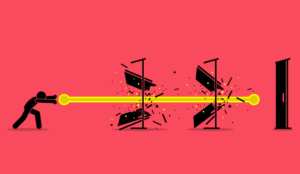Delivering an outstanding customer experience begins with equipping your agents to succeed. Something that, unfortunately, many contact centres fail to do. With pressure to maintain critical customer service metrics, agents and agent effort is often overlooked.
If you need more proof that organizations are focusing on the customer instead of agents, do a quick Google search with the keywords “reduce agent effort”. Nine out of ten results on the first page will be titled “Reducing Customer Effort”.
No one is arguing that you shouldn’t be thinking about customer effort. But doing so while ignoring agent effort is like taking one step forward and two steps back. You’re not really getting to the root of the problem. Because if you take care of agents, those customer service metrics that are so critical will take care of themselves.
So now that we’ve established its importance, let’s examine five different strategies that can have a big impact on reducing agent effort in your contact centre.
1. Measure and monitor agent effort – You can’t improve agent effort without having a clear view of your agents’ greatest challenges and what areas need the most improvement. If you’re unsure how to go about this, our last blog covers different ways you can measure agent effort.
2. Make communication with agents a priority – We live in a fast-paced world, and regardless of organization or industry, change is the only constant. So it’s important that agents are informed when there’s important product updates, pricing changes, or new corporate policies.
This ensures that as your business changes, the transition in your contact centre is seamless and customers will receive the same consistent level of customer service.
3. Make information easy to find – When information is hard to find, agents spend countless hours searching for answers to their questions in a knowledge base, asking their neighbours for help, or waiting for assistance from a supervisor. This drives higher AHT and longer hold times and will seriously hurt your customer satisfaction scores.
You can make sure that agents can find information quickly and easily when they need it by: eliminating duplication of documents, keeping your information in one central location, and condensing long text into simple and concise pieces of information.
4. Ensure your processes are easy to follow – Your information and processes may be easy to find, but this means nothing if your agents can’t easily follow them. Complexity, acronyms, industry jargon, and format are all factors that contribute to making processes difficult for agents to follow.
You can make your processes easier to follow by breaking down long processes into small simple steps, and laying them out in a visual and logical format.
5. A simple and effective training program – If agents finish training and find themselves unclear about many different topics and scenarios, they’ll do a lot of trial and error when they begin work. Your training should give agents the knowledge and skills required for them to do their job, and show them where to find important information.
This will prevent agents from feeling lost when starting work, and ensure they know exactly where to go for assistance when they need it.
Author: Robyn Coppell
Published On: 3rd Mar 2020 - Last modified: 19th Jul 2022
Read more about - Guest Blogs, ProcedureFlow















